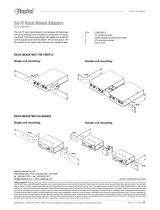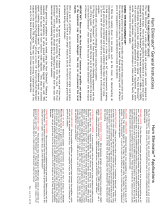
Radial Engineering JDI
™
User Guide
5
Getting to know your Radial JDI
As a rule, all direct boxes follow the same basic procedures when connecting them to a sound system. The instrument plugs
into the INPUT jack, the musician's instrument amplier connects to the THRU jack and the mixer or recorder is connected
to the XLR OUTPUT. Since the XLR output connection to the mixer taps the signal before it goes to the musician's amplier,
this allows the mixing engineer to ‘capture’ the signal before it is modied by the musician, thus resulting in the purest source
possible. It is important to note that what may sound good on stage may not necessarily sound good in the venue.
By sending an unaltered signal to the front of house mix position (FOH), the engineer is able to get the sound he is looking
for with minimal phase and harmonic distortion. This is likely the main reason why Radial direct boxes are so popular with
sound engineers — Radial DI’s do not alter the sound in any way before it gets to the mixing desk.
High to low impedance conversion and balancing
The Radial JDI features a high 140k Ohm input impedance for the instrument. As the signal passes through the JDI to the
XLR output, it is converted to a balanced 150 Ohm low impedance signal. This allows long cable runs without introducing
noise into the audio signal path. It is important to note that the output of the Radial JDI is a mic level signal. This allows the
JDI to be used along side other microphone signals without introducing cross-talk or causing transformer saturation when
driving the signal through the mic bridging transformers of a splitter.
The magic of a great transformer
The Radial JDI is a passive direct box. This means that it employs a transformer to convert the impedance and balance
the signal. At Radial, we believe quality should always be the most important deciding factor in any product design and the
best way to make great products is to use the very best parts. Many Radial products incorporate Jensen
®
audio transformers
which are expensive, but to an audiophile, these transformers are worth their weight in gold. A good transformer must be
able to pass every frequency between 20Hz and 20,000Hz awlessly. The transformer must also ensure that all of these
frequencies retain their time-base relationship or ‘absolute phase’. In other words, whatever you send in should come out
at the same time. If the bass and mid range are not synchronized in perfect phase, it simply will not sound as good.
A transformer is a simple device. It is basically made up of three components: (1) the primary or input coil, (2) the core
material and (3) the output coil. The audio signal enters the primary coil and taking full advantage of Faraday's law of
electromagnetism, the coil converts the electron impulse (current) into a magnetic eld. The core acts like a conduit to
contain the magnetic eld and drives it into the secondary coil. A magnetic eld, when driven into a coil, generates current
ow. Varying the number of windings on the input and the output allows us to control the input and output impedance ratio.
This is where the specication ‘10k : 150 Ohms’ comes from.
True to the Music
The JDI's parallel speaker connection feature lets you do this by connecting the JDI directly to the speaker cabinet. It is
important to note that the JDI is NOT a load box; you must have a load such as a speaker connected to the amplier, as
connecting the JDI directly without a load could cause severe damage to the equipment.
Connect your amp as usual, then connect a ¼” to ¼” speaker cable from the second (parallel) speaker cabinet jack to the
JDI. Because of the high impedance and low draw from the JDI, the amp will only see the speaker cabinet, so you do not
have to change the amplier's impedance setting. Depressing BOTH the -15dB PAD switch and the SPEAKER switch
inserts a special circuit that will protect the JDI from overload and allow the parallel speaker connection to be made safely.
Depressing the SPEAKER switch also introduces a band-pass lter circuit that rolls off high and low frequencies to simulate
the performance of a typical 12" speaker cabinet.
Mechanical attributes
All Radial products display the results of our relentless pursuit of durability. Look inside a JDI and you will note that it is
literally two boxes in one. First, there is an internal heavy-duty welded 'I-beam' chassis which houses the circuit board.
Second, an external shell with a ‘book-end’ design protects the switches and jacks from the rigors of touring. Both boxes
are made from 14 gauge steel and protected by a heavy baked enamel nish that will look great even after years of service.
Inside, the mil-spec PC board is two-sided which means that all components are soldered twice. Furthermore, the two
piece enclosure is very rigid making it impossible to torque the PC board ensuring years of noise-free performance without
solder joint failure.
The JDI is also outtted with a full bottom no-slip pad for two important reasons: it provides plenty of ‘stay-put’ friction on
hectic stages to keep your DI from sliding around or falling when stacked. It also works as an electrical isolator when placed
on or around guitar amps – many amp heads have handles or hardware which is sometimes connected to the amp's chassis
or circuit. The isolation pad helps minimize the possibility of shock hazards, especially with older ampliers.
J-Rak and J-Clamp optional mounting kits
The J-Rak is an innovative rack shelf/chassis that lets you rack-mount up to eight Radial
JDI's, J48's or the other similarly sized Radial J-Class products into a high-density 2-RU
space. Each unit can be front or rear mounted allowing the system designer to have
the XLR's on the front or rear of the rack, depending on the application. The J-Clamp
is a mounting adapter that allows any of the Radial J-Class products to be permanently
mounted in locations such as in podiums, under board room tables and inside amplier
and effect racks. Features a heavy-duty steel shell with built in mounting ange and
user-writable tabs.
Radial Engineering JDI
™
User Guide
10
True to the Music















